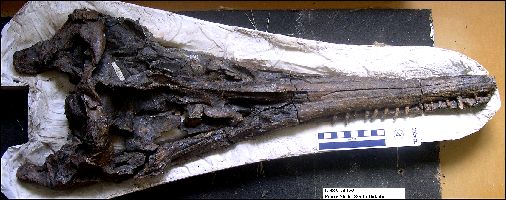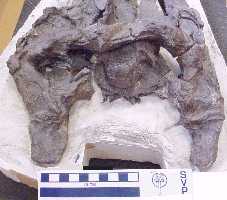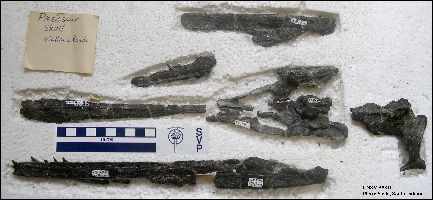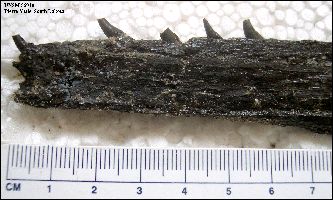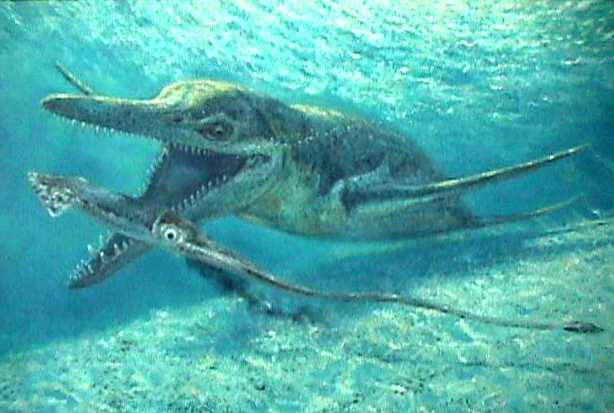 |
SOMETHING ABOUT PLIOSAURIDS AND
POLYCOTYLIDS
Copyright ©2001-2013 by Mike Everhart
Last revised 11/10/2013
LEFT: "Brachauchenius and squid" -Copyright © Dan Varner; used with permission of
Dan Varner
July 3, 2003 - Translated into French 
by Jean-Michel Benoit (Click on flag) |
Pliosaurid or Polycotylid?
Cretaceous plesiosaurs have been traditionally divided into two major
sub-groups; the long-necked, small headed "elasmosaurs" and the short-necked,
larger headed "pliosaurids." For a time, this was convenient for most purposes,
but it has become a somewhat arbitrary method of dividing the group since some of the
so-called "polycotylids" of the Late Cretaceous may be more closely related to
the elasmosaurs. The discussion of the systematics of plesiosaurs, however, is beyond the
scope of this article (see Carpenter 1996; and O'Keefe 2001; 2004, 2008 for a
further information).
On this this webpage, we will consider the pliosaurids to include the
large-headed, short-necked plesiosaurs, such as Kronosaurus and Brachauchenius
lucasi that became extinct about the Middle Turonian stage of the Late
Cretaceous, along with the polycotylid Trinacromerum bentonianum. Three
polycotylids, Polycotylus latipinnis, Dolichorhynchops osborni and D.
bonneri, lived during the latter part of the Late Cretaceous in the Western Interior
Sea
For information about plesiosaurs in general, and especially the long necked
variety, see the Something About Plesiosaurs webpage. Click
here for the latest information on Elasmosaurus platyurus.
For other Oceans of Kansas webpages about plesiosaurs, see: On
a dig for the New Jersey State Museum Plesiosaur; Completing
the Dig for the New Jersey State Museum Plesiosaur - 1992; We Dug Plesiosaurs-1998; Cincinnati
Museum Plesiosaur Dig in 1999; and the Styxosaurus snowii
elasmosaur at the South Dakota School of Mines. See also Ben Creisler's Plesiosaur Translation and
Pronunciation Guide for more information on plesiosaur names and their pronunciation.
How did plesiosaurs swim?? .... Consider the possibilities here: PLESIOSAUR SWIMMING --- Animations
on the Plesiosauria website by Adam Stuart Smith
PLIOSAURIDS:
Brachauchenius lucasi
| The only pliosaurid officially recognized from Kansas at
this time is Brachauchenius lucasi Williston 1903. A
few fragmentary specimens suggest one or more other species may have been present. In
Kansas, these short-necked pliosaurids are relatively rare, but are represented by two
excellent specimens, the largest of which is on exhibit at the Sternberg
Museum of Natural History. Also, see the Brachauchenius
webpage for more information. |
SYSTEMATIC PALEONTOLOGY
Order Plesiosauria, de Blainville 1835
Superfamily Plesiosauroidea, Welles 1943
Family Brachaucheniidae Williston 1925
Genus Brachauchenius lucasi Williston 1903 |
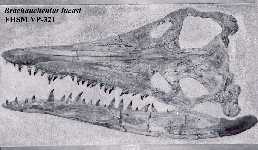 |
Certainly the largest of the Kansas pliosaurids is Brachauchenius lucasi. The holotype (USNM 4989) was
collected from the "Benton Formation" in Ottawa County, Kansas and was described
by Samuel Williston in 1903. A second specimen (UNSM 2361) was collected from the Eagle
Ford Formation near Austin, Texas, and described by Williston in 1907. The skull of a
third specimen (FHSM VP 321, shown here) is more complete and somewhat better preserved.
It was collected by George Sternberg in October, 1950, from the Fairport Chalk member of
the Carlile Shale, in Russell County, Kansas, and is on display in the Sternberg Museum at
Fort Hays State University. This skull is about five feet (152 cm) in length along the
mid-line, and must have come from a creature that was truly huge. Additional pictures are HERE. |
 |
LEFT: The partial skull of a Brachauchenius lucasi (UNSM
50136) specimen from an unknown locality in Kansas. Very similar in size and preservation
to FHSM VP-321 (above). RIGHT: A portion of the skull and a jaw with teeth of a Brachauchenius
lucasi specimen (UNSM 112437) from Mitchell County discovered in the Graneros Shale
during the construction of the Glen Elder Dam. Possibly the oldest known specimen of this
species. (Both specimens in the collection of the University of Nebraska State Museum) |
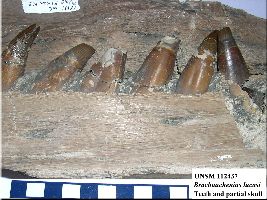 |
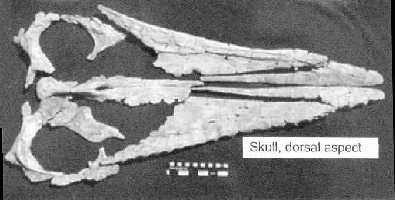 |
LEFT: Photograph (click to enlarge) of a recently discovered skull
and lower jaws of a Brachauchenius from the Glen Canyon National Recreation Area
in Utah. Skull is slightly less than a meter in length. This picture was part of a poster
presentation by David Gillette and Barry Albright at the 2003 Society of Vertebrate
Paleontology meeting in St. Paul, MN. |
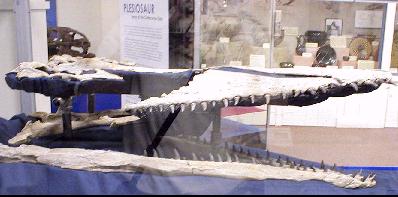 |
LEFT: This a photo of the same Brachauchenius specimen now on
exhibit in the John Wesley Powell Memorial Museum in Page, Arizona. According to
Merle Graffam, who is the co-discoverer of the specimen, there are more than ten separate
finds of pliosaurids in Utah. All are from the Tropic Shale (Upper Cenomanian -
Lower Turonian) and are about 93 million years old. (Photo by Merle Graffam) |
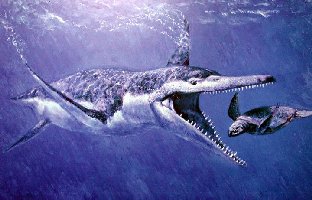 |
LEFT: Here a giant pliosaur (Brachauchenius
lucasi) is about to make lunch of a small turtle similar to Desmatochelys. Brachauchenius was one of the last of the
pliosaurs and made it's final appearance in Kansas during the deposition of the Fairport
Chalk Member (middle Turonian) of the Carlile Shale. Dan Varner © painting courtesy of the Museum of Northern Arizona. |
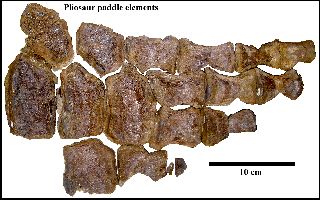 |
LEFT: A portion of the paddle of a
very large pliosaur (FHSM VP-13997) from the basal Lincoln Limestone Member of the
Greenhorn Limestone (Middle Cenomanian), Russell County, KS. The bones would have
come from a paddle that was about 2 m (6.5 ft) in length, and a Brachauchenius-like
pliosaur that was about 25 feet long. |
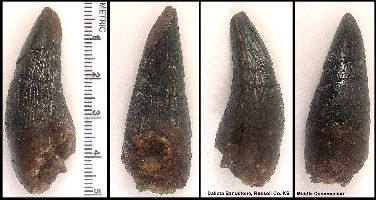 |
RIGHT: A large pliosaur tooth
collected from the upper Dakota Sandstone (Mid-Cenomanian) by Keith Ewell in 2004. The
tooth is most likely from Brachauchenius, and if so, would be the earliest report
of this genus anywhere. |
Kronosaurus:
Both Williston (1907) and Carpenter (1996) suggested that Brachauchenius
was closely related to Kronosaurus from the Early Cretaceous of Australia and to
the Jurassic pliosaurid, Liopleurodon.
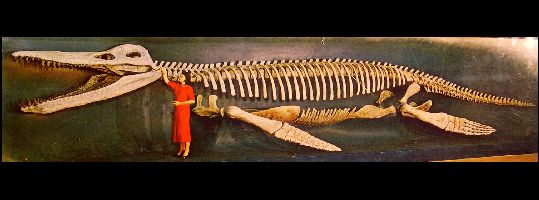 |
According to local sources in
Australia, Kronosaurus queenslandicus
was discovered by a station owner named Ralph William Haslam Thomas. The remains were dug
up by the Harvard expedition after they were shown where it was on his 20,000 acre
property "Army Downs" near Hughenden in central Queensland, Australia. Mr.
Thomas apparently had known about a row of large vertebrae poking out of the ground for
many years prior to the Harvard expedition. He in turn informed the Harvard team of its
existence. When it was finally dug up, the specimen was shipped to the United States
in 86 cases weighing approximately 6 tons. The export permit states that the specimen was
transported the SS Canadian Constructor about the 1st of December 1932. (Shaw
Studio photograph). Click here for an older black and
white photograph. |
POLYCOTYLIDS:
Shortly after the discovery of Elasmosaurus
platyurus by Dr. Theophilus Turner (Cope, 1868) in Pierre Shale of Logan County,
Kansas, another "new" kind of plesiosaur was found in the upper Smoky Hill Chalk
"about five miles west" of Fort Wallace (Cope, 1871, p. 386). A land agent and
part-time fossil hunter named W. E. Webb, discovered the remains of a much smaller
plesiosaur that Cope (1869) called Polycotylus latipinnis (USNM 27678) from a
pelvic arch and twenty-one vertebrae. The genus name refers to the deep
"cupping" of the anterior and posterior surfaces of the vertebrae, a character
that was quite different from other plesiosaur vertebrae seen by Cope up until then.
Following Webb's discovery, two other species of short necked plesiosaurs were
found in Kansas. One, Trinacromerum, was discovered in the underlying "Fort
Benton" Formation, and was much older than Polycotylus. The other, Dolichorhynchops,
was also found in the Smoky Hill Chalk and lived at the same time as Polycotylus.
Trinacromerum bentonianum
| Trinacromerum bentonianum Cragin 1888 was described from
two skulls (USNM 10945 -holotype and USNM 10946 - paratype) found in the (?) Fencepost
Limestone member of the Greenhorn Limestone (early Middle Turonian) in Osborne
County, Kansas. Carpenter (1996) assigned both Trinacromerum
and Dolichorhynchops to the Polycotylidae. |
SYSTEMATIC PALEONTOLOGY
Order Plesiosauria, de Blainville 1835
Superfamily Plesiosauroidea, Welles 1943
Family Polycotylidae, Cope 1869
Genus Trinacromerum Cragin 1888
Trinacromerum bentonianum Cragin 1888 |
 |
The specimen at upper left is the paratype skull (USNM 10946) in
ventral view. The drawing shows it as figured in Williston 1908. I had the opportunity to
photograph it in the Field Museum of Natural History, Chicago, IL, during my visit there
in August, 2002. A larger image of Williston's Fig. 1 is HERE. |
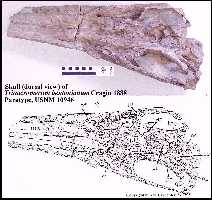 |
Carpenter (1996) figured the skull of Trinacromerum
bentonianum (USNM 10946 - paratype) in more detail than Williston. These figures are
from an early draft of the 1996 publication and are copyright © by Kenneth Carpenter;
used with permission of Ken Carpenter. LEFT: Dorsal view
RIGHT: Ventral view |
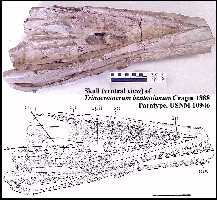 |
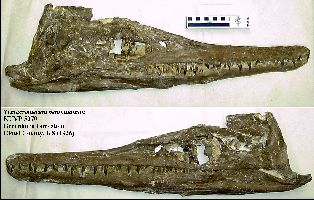 |
LEFT: A complete, articulated skull of Trinacromerum
bentonianum (KUVP 5070) in right and left lateral views. The specimen was
discovered in December, 1936, during the construction of a road-cut along U.S. 81 Highway,
south of Concordia (Cloud County), Kansas. This specimen was originally described in
1944 by Elmer Riggs and named Trinacromerum willistoni after S. W. Williston.
Per Carpenter (1996), the original name is a junior synonym of T. bentonianum. The
lower jaw measures 74.5 cm (29 inches). RIGHT: The distal end of the
jaws in right lateral view. The specimen consists of a complete skull with
mandible, fifty vertebrae (fifteen cervicals including the atlas-axis), ribs, most of the
pectoral girdle, both pubes and the ischia (Riggs, 1944). |
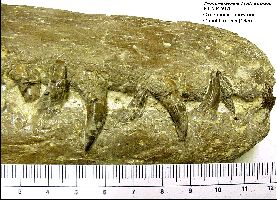 |
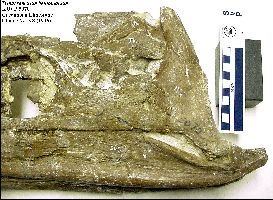 |
LEFT: The back of the skull of Trinacromerum bentonianum
(KUVP 5070) in left lateral view. Riggs (1944) noted that it occurred "10 feet
below the Jetmore Chalk member in beds which, futher west of this area, have been
classified as the Hartland Shale member of the Greenhorn Limestone formation. Carpenter
(1996) reassigned the specimen to T. bentonianum, and Schumacher and Everhart
(2005) reviewed Rigg's locality and stratigraphic information and confirmed the age as
Late Cenomanian. RIGHT: The cranial portion of the skull in right
lateral view (top) and the posterior portion of the skull in right lateral view (lower).
|
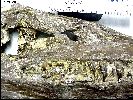 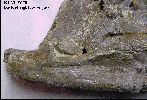 |
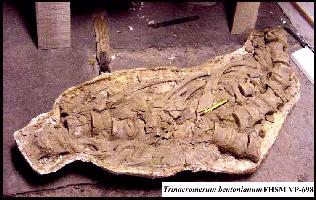 |
LEFT: Part of the remains of a large Trinacromerum bentonianum
(FHSM VP-698) found by George Dreher in Ellis County, Kansas. The specimen was collected
by George Sternberg and M. V. Walker in June, 1956 from the Blue Hill Shale Member of the
Carlile Shale and is Middle Turonian in age. The specimen consists of a 3 m (10 ft) string
of vertebrae, attached ribs and some limb elements. The axis-atlas vertebrae was included,
but the skull was not found. Sternberg's description of this jacket says; "In the
articulated column, this section fits between section 2 and 3. This section contains
about 21 continuous vertebrae and a number of ribs. The section is about 50" long and
is the widest and largest section in the series. Packages #4 and #5 go with the section,
also some loose rock slabs with rib elements." |
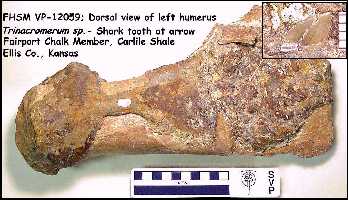 |
LEFT: A dorsal view of the left humerus of a Trinacromerum
bentonianum (FHSM VP-12059) in the Sternberg Museum collection, with an associated Squalicorax
falcatus tooth (inset). (Another bone here) RIGHT:
Shark bite marks on both sides of the left coracoid of VP-12059. (Fairport Chalk,
Ellis County, KS) |
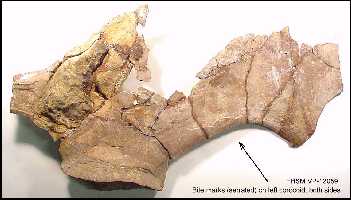 |
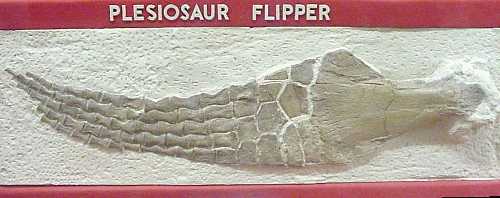 |
LEFT: The front paddle of another Trinacromerum bentonianum
(ESU 5000) that was found in the 1970s south of Wilson Lake in Russell County. The
locality is at the contact between the Greenhorn Limestone and the Fairport Chalk Member
of the Carlile Shale (early Middle Turonian). The paddle is about 1.1 m (43 in.) long Sadly,
however, the rest of the specimen was stolen from the dig site by unknown persons and was
never recovered. A single surviving paddle is on exhibit in the Johnston Museum of Geology,
Emporia State University, Emporia, Kansas. |
As an interesting side note (to me at least), the last known fossils of Trinacromerum
bentonianum in Kansas occur in the same rocks (Fairport Chalk and Blue Hill Shale
members of the Carlile Shale - Middle Turonian) as the first known remains of mosasaurs.
Polycotylus latipinnis:
| "[Cope] also explained, from specimens, the characters of a
large, new Plesiosauroid from Kansas, discovered by Wm. E. Webb,
of Topeka, which possessed deeply biconcave vertebrae, and anchylosed neural arches, with
the zygapophyses directed after the manner usual among vertebrates. The former was thus
shown to belong to the true Sauropterygia, and not to the Streptosauria, of which
Elasmosaurus was type. Several distal caudals were anchylosed, without chevron bones, and
of depressed form, while proximal caudals had anchylosed diapophyses and distinct chevron
bones. The form was regarded as new, and called Polycotylus latipinnis,
from the great relative stoutness of the paddle." E. D. Cope (1869). |
SYSTEMATIC PALEONTOLOGY
Order Plesiosauria, de Blainville 1835
Superfamily Plesiosauroidea, Welles 1943
Family Polycotylidae, Cope 1869
Genus Polycotylus Cope 1869
Polycotylus latipinnis Cope 1869 |
Polycotylus latipinnis was the second species of plesiosaur found in
Kansas. Cope (1875, p. 70) noted that the remains of the type specimen were found by
William Webb "about 5 miles WEST of Fort Wallace, on the plains near [the] Smoky Hill
River, Kansas, in a yellow Cretaceous limestone." The problem with this locality is
that there are no exposures of Smoky Hill Chalk 5 miles west of Fort Wallace. It is likely
that the locality is 5 miles east of Fort Wallace in the yellow Smoky Hill Chalk near the
Smoky Hill River. According to O'Keefe (2004), the remains consist of
"vertebrae, an ilium, and metapodials at the Smithsonian (USNM 27678) as well as more
vertebrae and assorted phalanges housed at the American Museum of Natural History (AMNH
1735). It is uncertain how the remains became divided among the two museums.
 |
LEFT: A cast of the left rear paddle of Polycotylus latipinnis
(KUVP 40002), part of a nearly complete specimen collected from the Pierre Shale of South
Dakota in the 1970s. |
 |
In 1903, Williston wrote "Some years ago, an excellent
specimen of a paddle of a plesiosaur (KUVP 5916) in the exhibit of the University of
Kansas Museum of Natural History) belonging in all probability to Polycotylus
latipinnis Cope was collected by Mr. George R. Allman of Wallace, Kansas, from the
upper Niobrara Chalk of the Smoky Hill River, east of Fort Wallace." Click here for more recent photo |
"The bones of the paddle were, for the most part, found in their natural
relations, but were separated in the collection of them. The radius and ulna of second
paddle, together with some of the smaller bones showed weathering, and doubtless had been
picked up from the surface. It has required but little trouble to fit into their
natural relations all the bones except the most of the phalanges, which, presenting no
lateral surfaces for articulation, could only be located from their other
characters."
Williston (1906, p. 233) noted that the "genus Polycotylus,
described by Cope in 1870 from a number of mutilated vertebrae and fragments of the podial
bones has remained hitherto much of a problem, and its characters have been very generally
misunderstood. Fortunately, there is an excellent specimen in the Yale Museum (No. 1125)
collected many years ago by the late Professor Marsh in the vicinity of Fort Wallace,
Kansas, from the Niobrara chalk, which I believe can be referred with certainty to the
type species P. latipinnis Cope. That it belongs to the genus Polycotylus
is beyond dispute, the vertebrae agreeing quite with the type as they do. This
species seems to be the most common one of the order in the Kansas chalk, and is
represented by several other specimens in the Yale Museum and by several specimens in the
University of Kansas collection."
Williston (1906, p. 234) went on to re-describe the species from what became the
"paratype" specimen - YPM 1125:
"Polycotylus. Teeth rather
slender, with numerous well marked ridges. Face with slender beak. Cervical vertebrae
twenty-six in number; dorsals twenty-eight or twenty-nine, inclusive of three
pectorals; all short and all of nearly uniform length. Chevrons articulating in a
deep concavity; all the vertebrae, and especially the cervicals, rather deeply concave,
and with a broad articular rim. Pectoral girdle with distinct clavicles, interclavicles,
and interclavicular foramen; the scapulae not contiguous in the middle. Coracoid with a
long anterior projection, united in the middle, back of the interglenoid bar, to the
posterior margin; a foramen on each side, back of interglenoid thickening. Ischia
elongated. Paddles with four epipodial bones all much broader than long."
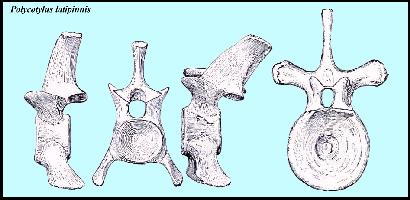 |
LEFT: Two cervical vertebrae of Polycotylus latipinnis
(YPM 1125) from the side and behind; and a dorsal vertebrae from the front. (Williston
1914, Fig. 34) RIGHT: A probable humerus and femur of Polycotylus
latipinnis (FFHM 1972.126.12f) in the collection of the Fick Fossil and History Museum, Oakley, KS. |
 |
 |
Dolichorhynchops osborni:
Note that these plesiosaurs were featured in the 2007 National Geographic
IMAX movie "Sea Monsters"
and in my book, "Sea Monsters - Prehistoric Creatures of the Deep." |
| Polycotylus latipinnis and Dolichorhynchops osborni
were the "end of the line" so far as the short-necked polycotylids were
concerned. Polycotylus is known only from fragmentary material, mostly
from the Smoky Hill Chalk, and more recently from Alabama (O'Keefe, 2004). The first two
examples of Dolichorhynchops osborni Williston 1903 were found by George
Sternberg in the Smoky Hill Chalk in Logan County, KS. Dolichorhynchops persists
into the Campanian and possibly the Maastrichtian (See Adams, 1997). A brief description of the skull of
Dolichorhynchops osborni as provided by Williston (1903:14) is repeated here:
"Head elongate, the facial region much attenuated; teeth nearly uniform in size,
small; prefrontal and postfrontal bones not joined; parietals extending into a high crest;
supraoccipital bones separated; internal nares small, included between the vomer and
palatine only; palatines broadly separated throughout; a large vacuity between the
pterygoids anteriorly; quadrate process of pterygoids short." |
SYSTEMATIC PALEONTOLOGY
Order Plesiosauria, de Blainville 1835
Superfamily Plesiosauroidea, Welles 1943
Family Polycotylidae, Cope 1869
Genus Dolichorhynchops Williston 1902
Dolichorhynchops osborni Williston 1902 |
 |
The mounted holotype of Dolichorhynchops osborni (KUVP
1300) at the University of Kansas Museum of Natural History, with a replica of the the
skull. Click for larger version of this picture and
click here for the 1946 version of this exhibit,
showing the original skull of the specimen. |
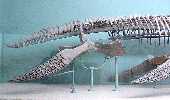 |
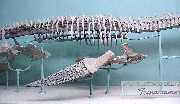 |
LEFT and RIGHT: Several closer views of the holotype specimen at
the University of Kansas. |
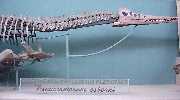 |
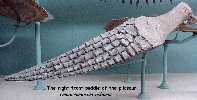 |
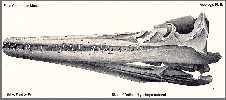 |
 |
LEFT and RIGHT: These photos show a drawing published by Williston
(1903) and the skull of the specimen in the KU collection. |
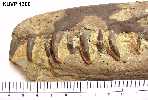 |
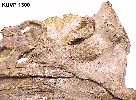 |
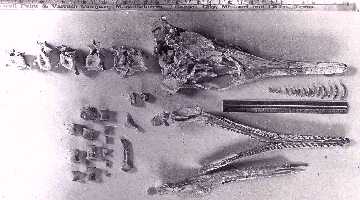 |
Rare pictures of a juvenile skull of Dolichorhynchops osborni found
by George F. Sternberg in 1926 in the Smoky Hill Chalk of Logan County, Kansas. George
also had the distinction of finding the type specimen (KUVP 1300, above) as a teenager in
1900. See Everhart (2004) for the history of this specimen. Photos by
George F. Sternberg (Smithsonian archives). |
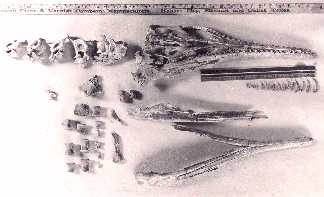 |
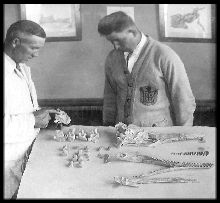 |
LEFT/ RIGHT: After being offered for sale to the Smithsonian and
the American Museum of Natural History, the specimen was mounted in plaster with just the
right side of the skull showing, and acquired by the Museum of Comparative Zoology
(MCZ) at Harvard University, Cambridge, MA. The specimen was curated as MCZ 1064. Photo by
George F. Sternberg (about 1926) - from the archives of the Sternberg
Museum. |
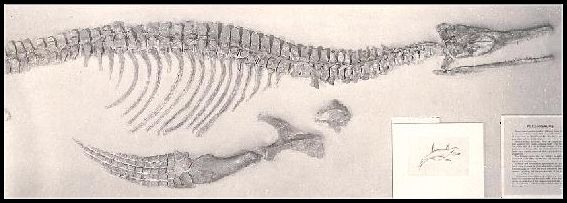 |
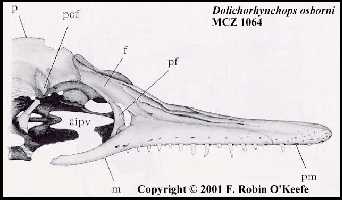 |
Unfortunately, the plaster mount hides most of the important
details of the skull from view. It was removed from the exhibit in the 1950s. The drawing
at left of the specimen was published recently by F. Robin O'Keefe and is used with
permission. (See: O'Keefe, F. R., 2001. A cladistic analysis and
taxonomic revision of the Plesiosauria (Reptilia: Sauropterygia). Acta Zool. Fennica
213:1-63.)
Also: O'Keefe, F. R. 2004. On the cranial anatomy of the
polycotylid plesiosaurs, including new material of Polycotylus latipinnis Cope,
from Alabama. Journal of Vertebrate Paleontology 24(2):326-340. |
 |
These recent pictures of MCZ-1064 were provided by Charles R.
Schaff, Curatorial Associate of the Museum of
Comparative Zoology and are used with his permission. LEFT: The
right side of the skull, and parts of the lower jaws
RIGHT: This photo shows the elements of the right rear paddle. The femur
is at the lower left, and an ileum (part of the pelvis) is at the upper right. |
 |
Everhart, M. J. 2004. New data regarding
the skull of Dolichorhynchops osborni (Plesiosauroidea: Polycotylidae) from
rediscovered photos of the Harvard Museum of Comparative Zoology specimen. Paludicola
4(3):74-80.
ABSTRACT: The Dolichorhynchops osborni specimen (MCZ 1064) in the Museum of
Comparative Zoology, Harvard University, Cambridge, Massachusetts, was the second of only
three nearly complete specimens of this species ever recovered from the Smoky Hill Chalk
Member of the Niobrara Chalk Formation (Upper Cretaceous). The remains were discovered by
George F. Sternberg in 1926 and later acquired by Harvard. Sternberg apparently mounted
the skull in a block of plaster that obscures many important details and limits its
usefulness. Recently re-discovered photos of the skull, included in correspondence sent by
Sternberg to Charles W. Gilmore in 1926, provide an excellent record of the original
appearance of this rare specimen. Measurements taken from these photographs are compared
with those published of other specimens of this species. |
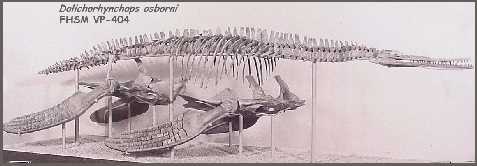 |
LEFT: A third, nearly complete specimen (FHSM VP 404, shown here
in right lateral view and below in 1960 vintage pictures) was found in Logan County by
Marion Bonner in October, 1955, and is currently on display in the Sternberg
Museum. View from the left side is HERE.
The specimen was described by Marion Bonner's son, Orville, in his 1964 Masters
thesis. See also Sternberg and Walker (1957).
In George F. Sternberg's records, there is a handwritten note that says.
"Plesiosaur Trinacromerum osborni presented 12-12-55 by the collector,
M.C. Bonner and son Orville, Leoti, Kans. to the College Museum." |
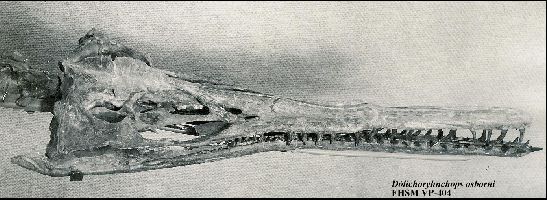 |
LEFT: A 1950s photo of the skull of Dolichorhynchops
osborni in right lateral view. The skull is long and narrow. It is also lightly
constructed and is almost always found severely crushed. The skull of this specimen in the
Sternberg Museum is about 16 inches long (51.3 cm), and probably came from a fairly young
individual. The skull of a larger individual
(KUVP 40001) found in Wyoming was over 3 feet (98 cm) long. Photo from the Sternberg
Museum of Natural History. NEW (12/2007) -
Detailed photographs of skull. |
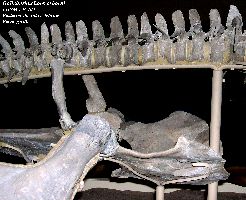 |
LEFT: This photo shows a left lateral view of the pelvis (pelvic
girdle) and a portion of the posterior dorsal vertebrae of the FHSM VP-404 specimen. Note
that the pelvic girdle is only attached to the vertebral column by two slender shafts of
bone.. the ilia... |
 |
Plesiosaur paddles (podials) are composed of five 'fingers' with
as many as fifteen bones per digit. The upper bone of the podial is the humerus (front) or
femur (rear) and the lower limb bones (and wrist or ankle) are greatly reduced in number
and function. These elements were held tightly together to form a rigid, wing shaped
paddle or 'airfoil'. By moving these paddles in a coordinated 'figure-eight' pattern, the
animal was more or less able to 'fly' swiftly though the water, much like a modern
penguin, in pursuit of it's prey. |
Below are two sets of drawings of polycotylid skulls from the
draft of a paper by Kenneth Carpenter (Denver Museum of Natural History)......"A
Review of Some Short Necked Plesiosaurs from the Cretaceous of North America". These
drawings are copyright © by Kenneth Carpenter, and used with the permission of Kenneth
Carpenter.
 |
Left lateral view of the skull of Dolichorhynchops osborni
(FHSM VP 404) in the Sternberg Museum, Fort Hays State University, Hays, KS. Click on
picture to see a dorsal and ventral view of the skull, and a dorsal view of the mandible
(110 kb .jpg file). Scale = 10cm. Copyright © by Kenneth Carpenter. NEW (12/2007) - Detailed photographs of skull. |
 |
LEFT: A left latero-dorsal view of the skull of a juvenile Dolichorhynchops
osborni (UCM 35059) at the University of Colorado Museum at Boulder, CO. Click
on skull to see dorsal and ventral views (84 kb .jpg file). Scale = 10 cm. Copyright © by
Kenneth Carpenter. The specimen consists of a partial skeleton of a
young individual from the Sharon Springs member of the Pierre Shale in Niobrara County,
Wyoming, and provides the most complete skull of a juvenile member of this species. |
When I visited the Field Museum in Chicago in 2002, I photographed
another specimen of Dolichorhynchops osborni (UNSM 50133) that was on loan from
the University of Nebraska State Museum. The pictures below show the top of the skull and
the back of the skull. A close-up of the anterior portion
of the jaws is shown here
Two of the largest polycotylid specimens known from the Western Interior Sea
(KUVP 40001 and 40002) were collected in the Sharon Springs Member of the Pierre Shale in
South Dakota and Wyoming. KUVP 40002 is a nearly complete skeleton, lacking most of the
skull.
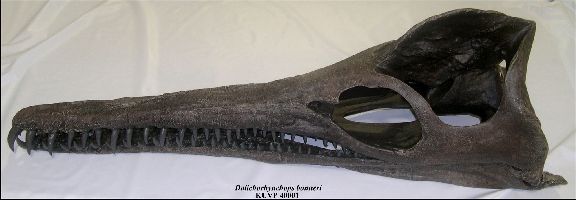 |
LEFT: A left lateral view of the reconstructed skull of Dolichorhynchops
bonneri (KUVP 40001) from the Pierre Shale of South Dakota. The new species was
described by O'Keefe in 2008. RIGHT: The same skull in posterior view.
SEE MORE ABOUT THIS SPECIMEN HERE |
 |
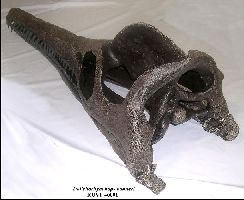 |
LEFT: An oblique, left posterio-lateral view of the reconstructed
skull (KUVP 40001). RIGHT: The skull as mounted on the reconstructed
skeleton of Dolichorhynchops bonneri in the Rocky Mountain Dinosaur Research
Center. |
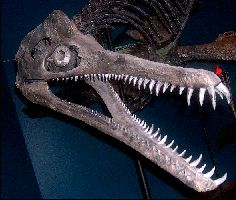 |
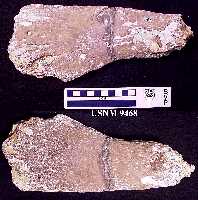 |
LEFT: One of the two
polycotylid propodials (USNM 9468) recovered from inside the rib cage of a Tylosaurus
proriger from the chalk of Logan County, Kansas (either a humerus or femur) by Charles
Sternberg and sons. Note partially digested appearance. See Everhart, M. J. 2003.
RIGHT: The second of two propodials
recovered by Sternberg, even more severely damaged by stomach acids.
FOR MORE ABOUT THIS SPECIMEN, CLICK HERE
Note that the discovery of this
specimen was the focus of the 2007 National Geographic IMAX film - Sea Monsters |
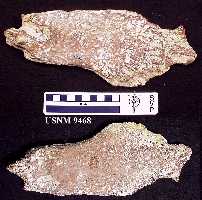 |
 |
LEFT: The femur (16 in / 40 cm long) of a very large Dolichorhynchops
osborni that was collected in 1992 from a concretion near the top of the Sharon
Springs Member of the Pierre Shale in Logan County. My wife, Pam, discovered this
specimen while the rest of us were working on the New Jersey State Museum Styxosaurus snowii. She had asked our friend, Pete Bussen, "What does a plesiosaur fossil look
like in the shale?" They walked up the hill for a look, and within ten minutes,
she picked up a small, sun-bleached paddle bone. She
had found her first plesiosaur. It was coming out of a large septarian concretion near the
top of the Sharon Springs Member of the Pierre Shale. Of course, finding was the easy
part; getting it out the concretion was a lot more difficult (and is the source of my
'flying shovel' story). |
Unfortunately, the concretion had shattered most of the bones and made a
difficult puzzle out of the specimen. It is incomplete and will never be an exhibit
specimen, but it is certainly an excellent example of how big these marine reptiles could
be. Ken Carpenter (Denver Museum of
Nature and Science) identified the remains for me in 1994. In 1999, we donated the
specimen (CMC VP-7055) to the Cincinnati Museum Center. I had the opportunity to take
these pictures in February, 2003.
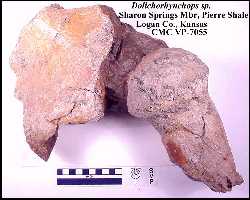 |
LEFT: This photo shows the nearly round head of an upper limb bone
(femur) and part of the hip, still held together by the matrix of the concretion. RIGHT: Centra of five caudal (tail) vertebrae. |
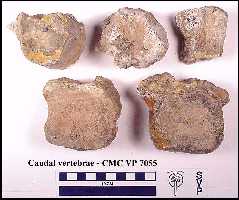 |
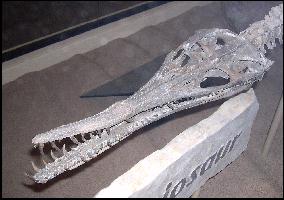 |
LEFT: A recent picture of the long, toothy skull of FHSM VP-404
on exhibit in the Sternberg Museum of Natural History. This plesiosaur was
definitely a fish-eater. (Age is Early Campanian) RIGHT: A skeletal
reconstruction of Dolichorhynchops osborni in the ancient seas exhibit at the
Smithsonian Institution (USNM V-419645). The specimen was collected in 1977 from Bearpaw
Shale the Custer Battlefield National Park in Montana. (Age is Campanian) |
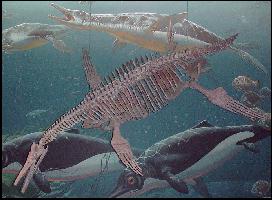 |
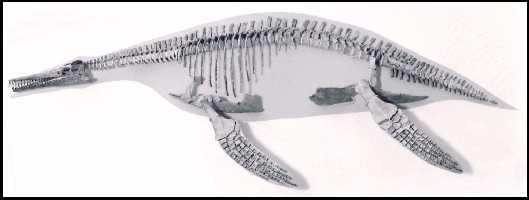 |
LEFT: This composite skeleton of Dolichorhynchops
osborni is one of the exhibits in the Vienna Museum of Natural History in Vienna
Austria. It was assembled from various sets of partial remains found in the chalk of
western Kansas. The skull is a replica. |
OTHER PLESIOSAUR REMAINS:
Unfortunately, plesiosaurs are few and far between in the Smoky
Hill chalk. What we do find occasionally are the scattered pieces
of plesiosaur carcasses that had been torn apart during scavenging by other predators. The
bones are unusually solid and heavy, but some still bear the marks of the teeth that
severed them from the plesiosaur's body.
 |
An 'as found' view of a lonely, sub-adult plesiosaur propodial (LACMNH 148920) eroding out on the surface of
the Smoky Hill chalk in Gove County, Kansas. From the serrated bite marks that were found
on the bone and the fact that no other plesiosaur material was found in the vicinity, it
seems apparent that this readily 'detachable' piece was torn away by scavenging sharks
before (Squalicorax) being dropped to the sea bottom. (See
Everhart, 2003) |
 |
Another 'detached' plesiosaur podial (length about 24 inches).
This specimen is on exhibit in the Fick Fossil and
History Museum in Oakley, Kansas. The deep bite marks on the upper portion of the bone
attest to the violence of the scavenging and the size of the scavenger (a large Late
Cretaceous shark, Cretoxyrhina mantelli). See
Everhart (2005). |
 |
This specimen represents the only plesiosaur skull (FHSM VP-13966) remains that we have ever found
in the chalk (Late Coniacian - about 86 mya). The bone fragments were scattered over a
large area and are mostly unrecognizable. They remained unidentified until we showed them
to J.D. Stewart of the Los Angeles County Museum of Natural History. The two semi-circular
shapes are the hinge points for the lower jaw of the plesiosaur, indicating another
possible 'detachable' part that was carried off by a shark. (See
Everhart, 2003) |
 |
A mosasaur's worst nightmare....when the hunter becomes the
hunted. A Brachauchenius-sized pliosaurid attacks a much smaller
mosasaur....not much of a fight. This encounter could only have occurred during the
Turonian, about 90 mya, because that was the only time that big pliosaurids and mosasaurs
lived together in the Western Interior Sea. This image is copyright © by Dan Varner, and
may not be used in any form without his written permission. |
 |
An upper limb bone or propodial of a young plesiosaur (species
indeterminate) found in the Bluffport Marl Member of the Demopolis Formation (Campanian)
in Clay County, Mississippi by Lynn Harrell, Jr. Length is about 8 inches / 20.5 cm.
In juvenile plesiosaurs, the limb bones were growing rapidly and the joints were composed
primarily of cartilage. Note the lack of articular surfaces on the ends of this bone
compared to some of the adult limb bones shown above. |
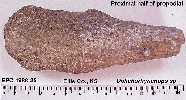 |
This a picture of the upper half of a partially digested, juvenile
plesiosaur propodial (FHSM VP-139632) which
was found near the base of the Smoky Hill Chalk (Late Coniacian) in Ellis County, Kansas
by the author in 1988. Unfortunately, the rest of the bone (and the animal itself) was no
where to be found. While plesiosaurs in general are not well documented from the lower
Smoky Hill Chalk, there are occasional remains that show they were there in small numbers.
(See Everhart, 2003), and that they were scavenged by sharks. |
 |
The Tate Museum in Casper, Wyoming, has a copy of a nearly
complete paddle from a what must have been a huge Jurassic pliosaurid (Megalneusaurus
rex). It was one of the largest marine predators that ever lived. Found
about 1898 by W. C. Knight (University of Wyoming) in Natrona County, Wyoming, this pliosaurid may have been 40 feet long and weighed as
much as 10 tons. The articulated paddle measures 7.25 feet (2.209 m). |
 |
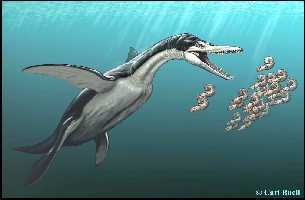 |
Trinacromerum bentonianum was an earlier Cretaceous
polycotylid that lived in the Western Interior Sea during Cenomanian - Turonian
time. It was quite similar in size and shape to Dolichorhynchops.
LEFT: Paleo-life art by Carl Buell. Copyright © by, and used
with the permission of Carl Buell. The original version of this picture was done by Carl
for Discover Magazine for a story done on this article: Sato, T. and K. Tanabe, 1998.
Cretaceous plesiosaurs ate ammonites, Nature, 394:629-630. Also,
polycotylid artwork by Peter Von Sholly, Russell Hawley, Doug
Henderson, Dan Varner and S. W. Williston. All are copyright © by the
respective artist and may not be reproduced without permission of the artist and Oceans of
Kansas Paleontology. |
--------------------------
The following comments about 'pliosaurids' and their possible
origin was written by Darren Naish and is reprinted here with his permission.
'Pliosaur' is an ambiguous term that, in the past, has been
applied to any plesiosaur with a shortish neck and large head. One group of such animals,
the mid-->Upper Cretaceous polycotylids, are very distinct from other 'pliosaurs' and
are almost certainly related to elasmosaurids (Bakker 1993 and Carpenter 1995, 1997). True
pliosaurids, in contrast, are primitive in the plesiosaur family tree as testified by
their complete set of mandibular bones, and out-group to all other plesiosaurs (clade
Plesiosauroidea). Pliosaurids first appear in the very earliest Jurassic (Hettangian) at
Dorset with Eurycleidus and other indeterminate taxa but did not (as far as is presently
known) make it as far as the late Upper Cretaceous (polycotylids made it to the end). The
term 'pliosaur' should not be used as it refers to an ecotype and not a clade.
Plesiosaurs represent a derived clade in the Sauropterygia Owen,
1860. This group contains a Triassic radiation of amphibious - marine forms long lumped
together as a paraphyletic 'Nothosauria' but now consisting of discrete clades that became
less land-dependent and more derived in style of paraxial locomotion (i.e. they grade up
to the flight of plesiosaurs). Glen Storrs recognizes the most derived 'nothosaurs' (Nothosaurus,
Pistosaurus and relatives) as forming the clade Nothosauriformes with the
plesiosaurs. Basal- and non-nothosauriforms are predominantly Tethyan in distribution and
the presence of the pachypleurosaurs - a clade of lizard-shaped amphibious, small-bodied
reptiles - here too suggests that this is the sauropterygian home. Pachypleurosaurs have
traditionally been regarded as 'nothosaurs' too but they are increasing regarded as a
sauropterygian out-group. Whatever, they are primitive members of the group that includes
plesiosaurs.
Placodonts are a problem. Rieppel and Storrs have them as true
sauropterygians, but this is mildly controversial. The most comprehensive and current view
of placodont relationships is a paper by Mazin in Geobios. It's in French and I
haven't understood it all yet. Cladistic analysis of sauropterygian and placodont
characters by Rieppel did nest Placodontia within Sauropterygia. If this view does not
become accepted, perhaps resurrection of a Euryapsida (Placodontia + Sauropterygia) will
do.
These reptiles are modified diapsids and may be neodiapsids up
there in the younginiform-sauria crown group. I'm unaware of any derived characters that
link sauropterygians (incl. placodonts) with either younginiforms or lepidosaurian
saurians (cases have been made for both alternatives). On the other hand, perhaps the
nearest relatives to sauropterygians are araescelidians (incl. Petrolacosaurus) in which
case they are basal diapsids and not neodiapsids. The description in recent years of a
(probable) marine araescelidian with swimming adaptations, Spinoequalis, implies
that this relationship is a possibility.
The full text of this comment is available at the Archives of the
DINOSAUR mailing list, June 9, 1997.
 |
Skeletal drawing of the polycotylid, Dolichorhynchops
osborni (Adapted from Buchanan, 1984, based on KUVP 1300)
|
For more information on Jurassic plesiosaurs: Adam
Smith's The Plesiosaur Directory
REFERENCES:
Adams, D. A. 1977. Trinacromerum bonneri, a new
polycotylid plesiosaur from the Pierre Shale of South Dakota and Wyoming.
Unpublished Masters thesis, University of Kansas, 97 pages.
Adams, D. A. 1997. Trinacromerum bonneri, new species,
last and fastest pliosaur of the Western Interior Seaway. Texas Journal of Science,
49(3):179-198. (See O'Keefe, F. R. 2008)
Bonner, O. W. 1964. An osteological study of Nyctosaurus
and Trinacromerum with a description of a new species of Nyctosaurus,
Unpub. Masters Thesis, Fort Hays State University, 63 pages.
Carpenter, K. 1996. A Review of short-necked plesiosaurs from the
Cretaceous of the western interior, North America, Neues Jahrbuch für Geologie und
Paläeontologie Abhandlungen, (Stuttgart) 201(2):259-287.
Carpenter, K. 1997. Comparative cranial anatomy of two North American Cretaceous
plesiosaurs, pp. 191-216, In Calloway, J. M. and E. L. Nicholls, (eds.), Ancient
Marine Reptiles, Academic Press.
Cicimurri, D. J. and M. J. Everhart. 2001. An elasmosaur with stomach contents and
gastroliths from the Pierre Shale (late Cretaceous) of Kansas. Kansas Academy of
Science, Transactions 104(3-4):129-143.
Cope, E. D. 1869. [Remarks on fossil reptiles, Clidastes
propython, Polycotylus latipinnis, Ornithotarsus immanis.]. Proceedings
of the American Philosophical Society xi p. 117. (meeting of June 18, 1869)
Cope, E. D. 1870. Remarks on fossil
reptiles from the Cretaceous of Kansas. Proceedings of the Academy of Natural
Sciences of Philadelphia, p. 132. (Polycotylus latipinnis)
Cope, E. D. 1875. The Vertebrata of the Cretaceous formations of the West.
Report, U. S. Geological Survey Territories (Hayden). 2:302 p, 57 pls.
Cragin, F. W. 1888. Preliminary description of a new or little known saurian
from the Benton of Kansas, American Geologist 2:404-407.
Druckenmiller, P. S. 1998. Osteology and relationships of
a plesiosaur (Sauropterygia) from the Thermopolis Shale (Lower Cretaceous) of Montana. Unpublished Masters Thesis, Montana State University.
Everhart, M. J. 2000. Gastroliths
associated with plesiosaur remains in the Sharon Springs Member of the Pierre Shale (late
Cretaceous), Western Kansas. Kansas Academy of Science, Transactions 103(1-2):58-69.
Everhart, M. J. 2003. First records of
plesiosaur remains in the lower Smoky Hill Chalk Member (Upper Coniacian) of the
Niobrara Formation in western Kansas. Kansas Academy of Science, Transactions
106(3-4):139-148.
Everhart, M. J. 2004. Plesiosaurs as the food
of mosasaurs; new data on the stomach contents of a Tylosaurus proriger (Squamata;
Mosasauridae) from the Niobrara Formation of western Kansas. The Mosasaur 7:41-46.
Everhart, M. J. 2004. New data regarding the skull of Dolichorhynchops
osborni (Plesiosauroidea: Polycotylidae) from rediscovered photos of the Harvard
Museum of Comparative Zoology specimen. Paludicola 4(3):74-80.
Everhart, M. J. 2005. Bite marks on an elasmosaur (Sauropterygia;
Plesiosauria) paddle from the Niobrara Chalk (Upper Cretaceous) as probable evidence of
feeding by the lamniform shark, Cretoxyrhina mantelli. PalArch, Vertebrate
paleontology 2(2): 14-24.
Everhart, M. J. 2005. Oceans of Kansas - A Natural History of the Western Interior
Sea. Indiana University Press, 320 pp.
ISBN: 0253345472
Everhart, M. J. 2007. Sea
Monsters: Prehistoric Creatures of the Deep. National Geographic, 192 p.
ISBN-13: 978-1426200854
Everhart, M. J. 2007. Historical note
on the 1884 discovery of Brachauchenius lucasi (Plesiosauria; Pliosauridae) in
Ottawa County, Kansas. Kansas Academy of Science, Transactions
110(3-4):255-258.
Everhart,
M.J. 2009. Probable plesiosaur remains from the Blue Hill Shale (Carlile Formation; Middle
Turonian) of north central Kansas. Kansas Academy of Science, Transactions
112(3/4):215-221.
Knight, W. C. 1898. Some new Jurassic
vertebrates from Wyoming. Amer. Jour. Sci., ser. 4, 5(29):378-380. [Megalneusaurus
rex, a giant pliosaurid]
Lingham-Soliar, T. 2000. Plesiosaur locomotion: Is the four-wing
problem real or merely an atheoretical exercise? Neues Jahrbuch für Geologie und
Paläeontologie Abhandlungen, (Stuttgart) 217:45-87.
Lucas, F. A. 1903. A new
plesiosaur. Smithsonian Miscellaneous Collections 45:96, pl. XXVIII (Quarterly Issue Vol.
1), 1457.
Lucas, S. G. 1994. Late Cretaceous pliosaurs (Eurapsida:
Plesiosauroida) from the Black Mesa Basin, Arizona, U. S. A. Journal of the Arizona-Nevada
Academy of Science 28(1/2):41-45.
Martin, J. E. and L. E. Kennedy. 1988. A plesiosaur from the late
Cretaceous (Campanian) Pierre Shale of South Dakota: A preliminary report, Proc. S.D.
Acad. Sci., 67:76-79.
Martin, J. E. and A. J. Kihm. 1988. Two unusual stratigraphic occurrences of plesiosaurs
from late Cretaceous formations of the Black Hills area, Wyoming and South Dakota. Proc.
S.D. Acad. Sci., 67:73-75.
Moodie, R. L. 1911. An embryonic plesiosaurian propodial, Trans.
Kansas Acad. Sci. 23:95-101, 9 figs, 1 pl.
O'Keefe, F. R. 1999. Phylogeny and convergence in the Plesiosauria. Journ.
Vert. Paleon. 19(3):67A. (abstract)
O'Keefe, F. R. 2001. A cladistic analysis and taxonomic revision
of the Plesiosauria (Reptilia: Sauropterygia). Acta Zool. Fennica 213:1-63.
O'Keefe, F. R. 2001. Ecomorphology of plesiosaur flipper
geometry. J. Evol. Biol. 14:987-991.
O'Keefe, F. R. 2002. The evolution of plesiosaur and pliosaur
morphotypes in the Plesiosauria (Reptilia: Sauropterygia). Paleobiology 28(1):101-112.
O'Keefe, F. R. 2004. On the cranial anatomy of the polycotylid
plesiosaurs, including new material of Polycotylus latipinnis Cope, from Alabama.
Journal of Vertebrate Paleontology 24(2):326-340.
O'Keefe,
F. R. 2008. Cranial anatomy and taxonomy of Dolichorhynchops
bonneri new combination, a polycotylid plesiosaur from the Pierre Shale of Wyoming
and South Dakota. Journal of Vertebrate Paleontology
28(3):664–676.
O’Keefe, F.R. and
Chiappe, L.M. 2011. Viviparity and K-selected life history in a Mesozoic marine
plesiosaur (Reptilia, Sauropterygia). Science 333(6044):870-873.
Riess, J. and E. Frey. 1991. The evolution of underwater flight
and the locomotion of plesiosaurs. pp. 131-144, In Rayner, J. M. V. and R.
J. Wooton (eds.), Biomechanics in evolution. Cambridge Univ. Press.
Riggs, E. S. 1944. A new polycotylid plesiosaur. University of
Kansas Science Bulletin 30:77-87.
Robinson, J. A. 1975. The locomotion of plesiosaurs, N. Jb. Geol. Paläont. Abh., 149,
3:286-332.
Russell, D. A. 1967. Cretaceous vertebrates from the Anderson
River N. W. T. Canadian Journal of Earth Sciences 4:21-38.
Russell, L. S. 1935. A plesiosaur from the Upper Cretaceous of
Manitoba. Jour. Paleon. 9:385-389.
Sato, T. and K. Tanabe. 1998. Cretaceous plesiosaurs ate
ammonites, Nature, 394:629-630.
Schmeisser,
R.L. and Gillette, D.D. 2009. Unusual occurrence
of gastroliths in a polycotylid plesiosaur from the Upper Cretaceous Tropic Shale,
southern Utah. PALAIOS 2009 24: 453-459.
Schultze, H.-P., L. Hunt, J. Chorn and A.M. Neuner. 1985. Type and
figured specimens of fossil vertebrates in the collection of the University of Kansas
Museum of Natural History, Part II. Fossil Amphibians and Reptiles. Miscellaneous
Publications of the University of Kansas Museum of Natural History 77:66 pp.
Schumacher, B. A. and M. J. Everhart. 2004. A new assessment of
plesiosaurs from the old Fort Benton Group, Central Kansas. Joint Annual Meeting of the
Kansas and Missouri Academies of Science, p. 50.
Schumacher, B.A. and M.J. Everhart. 2005. A stratigraphic and
taxonomic review of plesiosaurs from the old “Fort Benton Group” of central
Kansas: A new assessment of old records. Paludicola 5(2):33-54.
Schumacher, B. A. and J. E. Martin. 1995. Polycotylus
sp.: A short-necked plesiosaur from the Niobrara Formation (Upper Cretaceous) of South
Dakota. Jour. Vert. Paleon. 15(suppl. to 3):52A.
Sternberg, G. F. and M. V. Walker. 1957. Report on a plesiosaur skeleton from western Kansas. Kansas
Academy of Science, Transactions, 60(1):86-87.
Tarsitano, S. and J. Riess. 1982. Plesiosaur locomotion -
underwater flight versus rowing. Neues Jahrbuch für Geologie und Paläeontologie
Abhandlungen, (Stuttgart) 164:188-192.
Tarsitano, S. and J. Riess. 1982. Considerations concerning plesiosaur locomotion. Neues
Jahrbuch für Geologie und Paläeontologie Abhandlungen, (Stuttgart) 164:193-194.
Thurmond, J. T. 1968. A new polycotylid plesiosaur from the Lake
Waco Formation (Cenomanian) of Texas. Journal of Paleontology 42:1289-1296.
Williston, S. W. 1902. Restoration of Dolichorhynchops osborni,
a new Cretaceous plesiosaur, Kansas University Science Bulletin, 1(9):241-244, 1 plate.
Williston, S. W. 1903. North American
plesiosaurs, Field Columbian Museum, Pub. 73, Geological Series, 2(1):1-79, 29 plates.
Williston, S. W. 1906. North American plesiosaurs: Elasmosaurus,
Cimoliasaurus, and Polycotylus, American Journal of Science,
series 4, 21(123):221-234, 4 pl.
Williston, S. W. 1907. The skull of Brachauchenius, with special observations on
the relationships of the plesiosaurs. United States National Museum Proceedings
32:477-489. pls. 34-37.
Williston, S. W. 1908. North American plesiosaurs: Trinacromerum. Journal of
Geology 16:715-735. figs. 1-15.
Williston, S. W. 1914. Water reptiles of the past and present. Chicago Univ. Press. 251 pp
Other Plesiosaur information on the Internet:
KANSAS PLESIOSAURS
Barry Kazmer's Plesiosaur Paleontology:
Barry is digging plesiosaur remains from a quarry in southeastern South Dakota.
Plesiosaur References: A listing of
publications related to plesiosaurs from Barry Kazmer's Plesiosaur Paleontology web site.
Australian
Mesozoic Marine Reptiles Dann Pigdon's page about plesiosaurs, pliosaurs and
ichthyosaurs from Down Under.
Plesiosauria
Translation and Pronunciation Guide - An excellent reference by Ben Creisler
Giant
pliosaurs -- real and imaginary - A reality check on pliosaurids by Ben Creisler
Also,
you can visit Ray Ancog's Plesiosaur FAQ Page (Frequently Asked Questions)
Richard Forrest's listing
of plesiosaur specimens and literature - The Plesiosaur Site
Richard
Forrest's 5 Questions about Plesiosaurs (serious stuff!)
The Denver Museum elasmosaur (Thalassomedon
haningtoni)
"The longest neck in the
ocean" (University of Nebraska State Museum elasmosaurs)
A primer on the anatomy of the
plesiosaur skull.
Large gastroliths from a Kansas
elasmosaur.
Plesiosaur stomach contents and
gastroliths
Ben Creisler's Plesiosaur Translation and
Pronunciation Guide
Adam Stuart Smith's
Sea Saur Page
BACK TO THE INDEX

![]()

















































